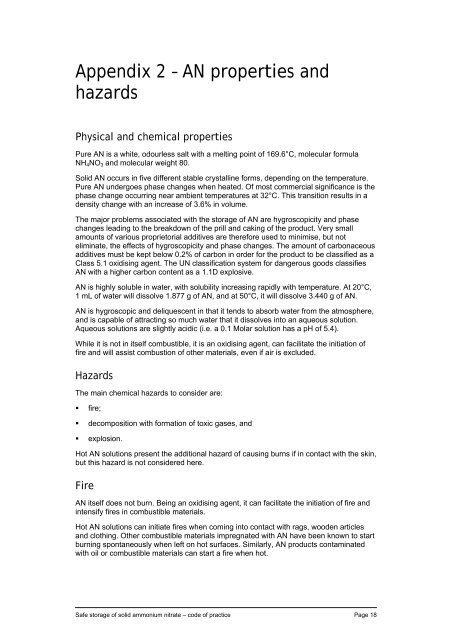Safe storage of solid ammonium nitrate Code of practice
Safe storage of solid ammonium nitrate Code of practice
Safe storage of solid ammonium nitrate Code of practice
Create successful ePaper yourself
Turn your PDF publications into a flip-book with our unique Google optimized e-Paper software.
Appendix 2 – AN properties and<br />
hazards<br />
Physical and chemical properties<br />
Pure AN is a white, odourless salt with a melting point <strong>of</strong> 169.6°C, molecular formula<br />
NH4NO3 and molecular weight 80.<br />
Solid AN occurs in five different stable crystalline forms, depending on the temperature.<br />
Pure AN undergoes phase changes when heated. Of most commercial significance is the<br />
phase change occurring near ambient temperatures at 32°C. This transition results in a<br />
density change with an increase <strong>of</strong> 3.6% in volume.<br />
The major problems associated with the <strong>storage</strong> <strong>of</strong> AN are hygroscopicity and phase<br />
changes leading to the breakdown <strong>of</strong> the prill and caking <strong>of</strong> the product. Very small<br />
amounts <strong>of</strong> various proprietorial additives are therefore used to minimise, but not<br />
eliminate, the effects <strong>of</strong> hygroscopicity and phase changes. The amount <strong>of</strong> carbonaceous<br />
additives must be kept below 0.2% <strong>of</strong> carbon in order for the product to be classified as a<br />
Class 5.1 oxidising agent. The UN classification system for dangerous goods classifies<br />
AN with a higher carbon content as a 1.1D explosive.<br />
AN is highly soluble in water, with solubility increasing rapidly with temperature. At 20°C,<br />
1 mL <strong>of</strong> water will dissolve 1.877 g <strong>of</strong> AN, and at 50°C, it will dissolve 3.440 g <strong>of</strong> AN.<br />
AN is hygroscopic and deliquescent in that it tends to absorb water from the atmosphere,<br />
and is capable <strong>of</strong> attracting so much water that it dissolves into an aqueous solution.<br />
Aqueous solutions are slightly acidic (i.e. a 0.1 Molar solution has a pH <strong>of</strong> 5.4).<br />
While it is not in itself combustible, it is an oxidising agent, can facilitate the initiation <strong>of</strong><br />
fire and will assist combustion <strong>of</strong> other materials, even if air is excluded.<br />
Hazards<br />
The main chemical hazards to consider are:<br />
fire;<br />
decomposition with formation <strong>of</strong> toxic gases, and<br />
explosion.<br />
Hot AN solutions present the additional hazard <strong>of</strong> causing burns if in contact with the skin,<br />
but this hazard is not considered here.<br />
Fire<br />
AN itself does not burn. Being an oxidising agent, it can facilitate the initiation <strong>of</strong> fire and<br />
intensify fires in combustible materials.<br />
Hot AN solutions can initiate fires when coming into contact with rags, wooden articles<br />
and clothing. Other combustible materials impregnated with AN have been known to start<br />
burning spontaneously when left on hot surfaces. Similarly, AN products contaminated<br />
with oil or combustible materials can start a fire when hot.<br />
<strong>Safe</strong> <strong>storage</strong> <strong>of</strong> <strong>solid</strong> <strong>ammonium</strong> <strong>nitrate</strong> – code <strong>of</strong> <strong>practice</strong> Page 18

















